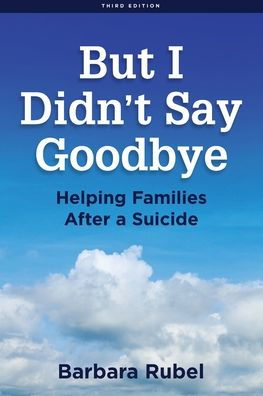Home
But I Didn't Say Goodbye: Helping Families After a Suicide
Loading Inventory...
Barnes & Noble
But I Didn't Say Goodbye: Helping Families After a Suicide
Current price: $17.95


Barnes & Noble
But I Didn't Say Goodbye: Helping Families After a Suicide
Current price: $17.95
Loading Inventory...
Size: Paperback
*Product Information may vary - to confirm product availability, pricing, and additional information please contact Barnes & Noble
The first and second edition of But I Didn’t Say Goodbye are being replaced by the 3rd Edition ISBN 9781892906021. The 3rd Edition reflects everything you need to know when providing support to suicide loss survivors.
Barbara Rubel's fictional characters in
are a compilation of what individuals may experience throughout their lifetime as a suicide loss survivor.
tells the story, from the perspective of an eleven-year-old boy, Alex, and his family, as they are rocked by suicide and reeling from the aftermath. Through Alex’s eyes, the reader will see the transformation of feelings after going through a death by suicide.
New to the third edition, each chapter ends with Alex reflecting 10 years later on his experience, introducing family members and friends in his recollections. Barbara Rubel has combined our modern academic theories of grieving, and the research that supports those theories, and then translated them into a readable story for anyone bereaved by suicide. The revised edition is an evidence-informed and contemporary treatment of a devastating form of loss that uses the artful device of a hypothetical case study to render it in human terms.
Through the story, the reader will understand what losing someone to suicide might be like for a family, how to make meaning in the loss, and ways to experience personal growth. This self-help book was revised to provide guidance and education for clinicians (e.g., mental health providers, social workers, psychologists, school counselors, and case managers) and families to help suicide loss survivors.
Part 1 offers a basic understanding of suicide postvention, suicide loss survivors, complicated grief, mourning theories, the American death system, and the impact on clinician survivors. Chapters have been substantially updated, based on mourning models and the latest research. The chapters in Part 2 build upon one another sequentially, from the day of the suicide to the anniversary of the death. At the end of each chapter, there are follow-up questions to explore in counseling sessions, support groups, therapy sessions, or at home. Also, at the end of each chapter, Alex, at the age of 21, reflects back on how his father’s death by suicide has changed his life, wounding him, but also helping him to grow.









